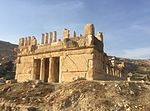Search results
Appearance
There is a page named "Lachish letters" on Wikipedia
- The Lachish Letters are a series of letters written in carbon ink containing ancient Israelite inscriptions in Ancient Hebrew on clay ostraca. The letters...10 KB (1,208 words) - 10:55, 19 July 2024
- named in honor of the ancient city. Lachish was first mentioned in the Amarna letters. In the Book of Joshua, Lachish is cited as one of the cities conquered...45 KB (5,146 words) - 04:06, 31 July 2024
- Uriah (prophet) (section Lachish Letters)is not certain, there is a scholarly opinion that Uriah might be referenced in the Lachish letters. See Lachish letters. Jeremiah 26:20–23 v t e v t e...1 KB (100 words) - 09:27, 25 November 2023
- Tetragrammaton (section Four letters)found in a tomb at Khirbet Beit Lei. Yahweh is mentioned also in the Lachish letters (587 BCE) and the slightly earlier Tel Arad ostraca, and on a stone...125 KB (13,012 words) - 01:30, 24 August 2024
- times in the Book of Jeremiah while the name Yaush appears in the Lachish letters. However, the combination of names was unknown to scholars. In 2007...18 KB (2,148 words) - 03:14, 13 August 2024
- Maccabees. These are supplemented by biblical references, the letters from Nimrud, the Lachish letters, and archaeological remains of the Tobiad estate in Iraq...42 KB (5,625 words) - 01:01, 25 May 2024
- referred to as the Lachish letters, were discovered during excavations; one, which was probably written to the commander at Lachish from an outlying base...33 KB (3,437 words) - 22:11, 20 August 2024
- Kingdom, a method well-documented in the Book of Jeremiah and the Lachish letters. According to the biblical account, the United Kingdom of Israel was...65 KB (7,611 words) - 18:53, 2 September 2024
- Ages until the end of the 18th century. Chemical tests made on the Lachish letters (c. 588–586 BCE) showed the possible presence of iron. It is thought...25 KB (1,845 words) - 00:54, 27 August 2024
- most significant discoveries ever made" for biblical studies. Lachish letters – letters written in carbon ink by Hoshaiah (cf. Nehemiah 12:32, Jeremiah...70 KB (4,688 words) - 00:34, 30 August 2024
- probably ibex Lachish Lachish letters Lachish reliefs LMLK seal Kuntillet Ajrud inscriptions Ta'anach cult stand Hestrin, Ruth (1987). "The Lachish Ewer and...6 KB (515 words) - 14:49, 15 May 2024
- [I burned] with fire… Azekah is also mentioned in one of the Lachish letters. Lachish Letter 4 suggests that Azekah was destroyed, as they were no longer...29 KB (3,353 words) - 15:12, 20 August 2024
- Zimredda (Lachish mayor) was a leader of Lachish in the mid 14th century BC. He is mentioned in the Amarna letters, and is the author of EA 329, (EA for...2 KB (225 words) - 15:44, 1 September 2023
- Canaanite and Aramaic inscriptions Three shekel ostracon Samaria ostraca Lachish letters Pike 2020, p. 203: About two hundred inscriptions were discovered at...16 KB (1,492 words) - 16:45, 17 April 2024
- Inscription from Babylon, Iraq, (604–562 BC) Lachish Letters, group of ostraka written in alphabetic Hebrew from Lachish, Israel, (586 BC) Cylinder of Nabonidus...228 KB (24,836 words) - 05:04, 3 September 2024
- by Egypt until the last invasion by Merneptah in 1207 BCE. The Amarna Letters are an example of a specific period during the Late Bronze Age when the...107 KB (12,453 words) - 19:21, 30 August 2024
- Shekem Shereq List of artifacts significant to the Bible Arad ostraca Lachish letters Faigenbaum-Golovin, Shira; Shaus, Arie; Sober, Barak; Turkel, Eli;...9 KB (1,071 words) - 13:25, 22 July 2024
- in Amarna letters, and in Phoenician. Yet, usage of vav-consecutive with perfect in a narration is unique to Hebrew. The Lachish letters, dating to c...12 KB (1,577 words) - 05:55, 14 August 2024
- Paleo-Hebrew alphabet (section Table of letters)developed cursive script is found on the 18 Lachish ostraca, letters sent by an officer to the governor of Lachish just before the destruction of the First...38 KB (3,810 words) - 02:29, 6 August 2024
- times in the Book of Jeremiah while the name Yaush appears in the Lachish letters. However, the combination of names was unknown to scholars. During...11 KB (1,419 words) - 01:12, 28 March 2024
- was in touch with a general rising in S.W. Palestine, in which Ekron, Lachish, Ascalon (Ashkelon) and other towns of the Philistines were supported by














